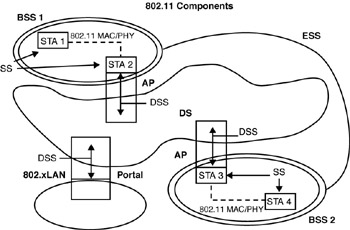Logical Service Interfaces
|
|
The IEEE 802.11 architecture allows for the possibility that the DS may not be identical to an existing wired LAN. A DS may be created from many different technologies including current IEEE 802 wired LANs. IEEE 802.11 does not constrain the DS to be either data link or network layer based. Nor does IEEE 802.11 constrain a DS to be either centralized or distributed in nature. IEEE 802.11 explicitly does not specify the details of DS implementations. Instead, IEEE 802.11 specifies services. The services are associated with different components of the architecture. There are two categories of IEEE 802.11 service — the station service (SS) and the DSS. Both categories of service are used by the IEEE 802.11 MAC sublayer.
The complete set of IEEE 802.11 architectural services are as follows:
-
Authentication
-
Association
-
Deauthentication
-
Disassociation
-
Distribution
-
Integration
-
Privacy
-
Reassociation
-
MSDU delivery
This set of services is divided into two groups: those that are part of every STA and those that are part of a DS.
Station Service (SS)
The service provided by stations is known as the SS. The SS is present in every IEEE 802.11 station (including APs, as APs include station functionality). The SS is specified for use by MAC sublayer entities. All conformant stations provide SS. The SSs are as follows:
-
Authentication
-
Deauthentication
-
Privacy
-
MSDU delivery
Distribution System Service (DSS)
The service provided by the DS is known as the DSS. These services are represented in the IEEE 802.11 architecture by arrows within the APs, indicating that the services are used to cross media and address space logical boundaries. This is the convenient place to show the services in the picture. The physical embodiment of various services may or may not be within a physical AP. The DSSs are provided by the DS. They are accessed via an STA that also provides DSSs. An STA that provides DSS access is called an AP. The DSSs are as follows:
-
Association
-
Disassociation
-
Distribution
-
Integration
-
Reassociation
DSSs are specified for use by MAC sublayer entities.
Figure 5-6 combines the components from previous figures with both types of services to show the complete IEEE 802.11 architecture.

Figure 5-6: Complete IEEE 802.11 architecture
Multiple Logical Address Spaces
Just as the IEEE 802.11 architecture allows for the possibility that the WM, DSM, and an integrated wired LAN may all be different physical media, it also allows for the possibility that each of these components may be operating within different address spaces. IEEE 802.11 only uses and specifies the use of the WM address space.
Each IEEE 802.11 PHY operates in a single medium — the WM. The IEEE 802.11 MAC operates in a single address space. MAC addresses are used on the WM in the IEEE 802.11 architecture. Therefore, it is unnecessary for the standard to explicitly specify that its addresses are WM addresses. This is assumed throughout the 802.11 standard.
IEEE 802.11 has chosen to use the IEEE 802 48-bit address space. Thus, IEEE 802.11 addresses are compatible with the address space used by the IEEE 802 LAN family. The IEEE 802.11 choice of address space implies that for many instantiations of the IEEE 802.11 architecture, the wired LAN MAC address space and the IEEE 802.11 MAC address space may be the same. In those situations where a DS that uses MAC-level IEEE 802 addressing is appropriate, all three of the logical address spaces used within a system could be identical. Although this is a common case, it is not the only combination allowed by the architecture. The IEEE 802.11 architecture allows for all three logical address spaces to be distinct.
A multiple address space example is one in which the DS implementation uses network layer addressing. In this case, the WM address space and the DS address space would be different.
The capability of the architecture to handle multiple logical media and address spaces is key to IEEE 802.11’s capability to be independent of the DS implementation and to interface cleanly with network layer mobility approaches. The implementation of the DS is unspecified and is beyond the scope of the 802.11 standard.
|
|
EAN: N/A
Pages: 88